Reliability Optimization of a Railway Network
Abstract
1. Introduction
2. Related Works
3. Definitions of Reliability and Reliability Optimization Model of a Railway Network
3.1. Small Cases and the Concept of Reliability
3.1.1. Case 1
3.1.2. Case 2
3.1.3. Case 3
3.2. Definition of Connection Reliability
3.3. Reliability Network Optimization Model Based on Reliability
4. Computing Case
5. Results Analysis
6. Conclusions
Author Contributions
Funding
Data Availability Statement
Acknowledgments
Conflicts of Interest
Appendix A
References
- Lee, T.S.; Ghosh, S. Stability of RYNSORD–A decentralized algorithm for railway networks under perturbations. IEEE Trans. Veh. Tech. 2001, 50, 287–301. [Google Scholar] [CrossRef]
- Sen, P.; Dasgupta, S.; Chatterjee, A.; Sreeram, P.A.; Mukherjee, G.; Manna, S.S. Small-world properties of the Indian railway network. Phys. Rev. 2003, 67, 36106. [Google Scholar] [CrossRef] [PubMed]
- Seaton, K.A.; Hackett, L.M. Stations, trains and small-world networks. Phys. Sect. A 2004, 339, 635–644. [Google Scholar] [CrossRef]
- Chen, S.; Hsu, S.C.; Tseng, C.T.; Yan, K.H.; Chou, H.Y.; Too, T.M. Analysis of rail potential and stray current for Taipei Metro. IEEE Trans. Veh. Technol. 2006, 55, 67–75. [Google Scholar] [CrossRef]
- Li, W.; Cai, X. Empirical analysis of a scale-free railway network in China. Phys. Sect. A Stat. Theor. Phys. 2007, 382, 693–703. [Google Scholar] [CrossRef]
- Ghosh, S.; Banerjee, A.; Sharma, N.; Agarwal, S.; Ganguly, N. Statistical analysis of the Indian railway network: A complex network approach. Acta Phys. Pol. B Proc. Suppl. 2011, 2, 123–138. [Google Scholar] [CrossRef]
- Martí-Henneberg, J. European integration and national models for railway networks (1840–2010). J. Transp. Geogr. 2013, 26, 126–138. [Google Scholar] [CrossRef]
- Innocenti, A.; Marini, L.; Meli, E.; Pallini, G.; Rindi, A. Development of a wear model for the analysis of complex railway networks. Wear 2014, 309, 174–191. [Google Scholar] [CrossRef]
- Meng, X.; Xiang, W.; Wang, L. Controllability of train service network. Math. Probl. Eng. 2015, 631492. [Google Scholar] [CrossRef]
- Yang, Y.H.; Liu, Y.X.; Zhou, M.X.; Li, F.X.; Sun, C. Robustness assessment of urban rail transit based on complex network theory: A case study of the Beijing Subway. Saf. Sci. 2015, 79, 149–162. [Google Scholar] [CrossRef]
- Hu, M.; Zhong, Z.; Ni, M.; He, R. Analysis of link lifetime with auto-correlated shadowing in high-speed railway networks. IEEE Commun. Lett. 2015, 19, 2106–2109. [Google Scholar] [CrossRef]
- Wandelt, S.; Wang, Z.; Sun, X. Worldwide railway skeleton network: Extraction methodology and preliminary analysis. IEEE Trans. Intell. Transp. Syst. 2017, 18, 2206–2216. [Google Scholar] [CrossRef]
- Zhao, W.; Martin, U.; Cui, Y. Operational risk analysis of block sections in the railway network. J. Rail Transp. Plan. Manag. 2017, 7, 245–262. [Google Scholar] [CrossRef]
- Lu, Q. Modeling network resilience of rail transit under operational incidents. Transp. Res. Part A 2018, 117, 227–237. [Google Scholar] [CrossRef]
- Caset, F.; Vale, D.S.; Viana, C.M. Urban Networks Special Issue: Measuring the accessibility of railway stations in the brussels regional express network: A node-place modeling approach. Netw. Spat. Econ. 2018, 18, 1–36. [Google Scholar]
- Alessio, P.; Guillem, M.; Aseel, A.; Samuel, J.; Stephen, J.; Alan, W.; Weisi, G.; Liz, V. Resilience or robustness: Identifying topological vulnerabilities in rail networks. R. Soc. Open Sci. 2019, 2, 181301. [Google Scholar]
- Cats, O.; Krishnakumari, P. Metropolitan rail network robustness. Phys. A Stat. Mech. Appl. 2020, 549, 124317. [Google Scholar] [CrossRef]
- Olentsevich, V.A.; Belogolov, Y.I.; Grigoryeva, N.N. Analysis of reliability and sustainability of organizational and technical systems of railway transportation process. IOP Conf. Ser. Mater. Sci. Eng. 2020, 832, 012061. [Google Scholar] [CrossRef]
- Fang, C.; Dong, P.; Fang, Y.; Zio, E. Vulnerability analysis of critical infrastructure under disruptions: An application to China Railway High-speed. Proc. Inst. Mech. Eng. Part O J. Risk Reliab. 2020, 234, 235–245. [Google Scholar] [CrossRef]
- Zhu, H.; Zhang, C. Expanding a complex networked system for enhancing its reliability evaluated by a new efficient approach. Reliab. Eng. Syst. Saf. 2019, 188, 205–220. [Google Scholar] [CrossRef]
- Gu, S. Reliability analysis of high-speed railway network. Proc. Inst. Mech. Eng. Part O J. Risk Reliab. 2019, 233, 1060–1073. [Google Scholar] [CrossRef]
- Hossain, M.M.; Alam, S. A complex network approach towards modeling and analysis of the Australian Airport Network. J. Air Transp. Manag. 2017, 60, 1–9. [Google Scholar] [CrossRef]
- Daganzo, C.F. Structure of competitive transit networks. Transp. Res. Part B Methodol. 2010, 44, 434–446. [Google Scholar] [CrossRef]
- Sullivan, J.L.; Aultman-Hall, L.; Novak, D.C. A review of current practice in network disruption analysis and an assessment of the ability to account for isolating links in transportation networks. Transp. Lett. 2009, 1, 271–280. [Google Scholar] [CrossRef]
- Tian, Z.W.; Zhang, Z.; Wang, H.F.; Ma, L. Complexity analysis on public transport networks of 97 large- and medium-sized cities in China. Int. J. Mod. Phys. B 2018, 32. [Google Scholar] [CrossRef]
- Currie, G.; Delbosc, A. Assessing bus rapid transit system performance in Australasia. Res. Transp. Econ. 2014, 48, 142–151. [Google Scholar] [CrossRef]
- Reynaud, F.; Sider, T.; Hatzopoulou, M.; Eluru, N. Extending the network robustness index to include emissions: A holistic framework for link criticality analysis for Montreal transportation system. Transp. Lett. 2016, 10, 302–315. [Google Scholar] [CrossRef]
- Doana, K.; Ukkusuria, S. Measuring inefficiency in dynamic traffic networks: A numerical study. Transp. Lett. 2015, 7, 154–167. [Google Scholar] [CrossRef]
- Loustau, P.; Morency, C.; Trépanier, M.; Gourvil, L. Travel time reliability on a highway network: Estimations using floating car data. Transp. Lett. 2010, 2, 27–37. [Google Scholar] [CrossRef]
- Sun, D.; Guan, S. Measuring vulnerability of urban metro network from line operation perspective. Transp. Res. Part A 2016, 94, 348–359. [Google Scholar] [CrossRef]
- Zhang, J.H.; Xu, X.M.; Hong, L.; Wang, S.; Fei, Q. Networked analysis of the Shanghai subway network, in China. Phys. A 2011, 390, 4562–4570. [Google Scholar] [CrossRef]
- Febbraro, A.D.; Giglio, D.; Sacco, N. On analyzing the vulnerabilities of a railway network with Petri nets. Transp. Res. Procedia 2017, 27, 553–560. [Google Scholar] [CrossRef]
- Li, M.; Wang, Y.; Jia, L.; Cui, Y. Risk propagation analysis of urban rail transit based on network model. Alex. Eng. J. 2020, 59, 1319–1331. [Google Scholar] [CrossRef]
- Jiang, R.Y.; Lu, Q.C.; Peng, Z.R. A station-based rail transit network vulnerability measure considering landuse dependency. J. Transp. Geogr. 2018, 66, 10–18. [Google Scholar] [CrossRef]
- Zhong, H.L.; Wang, J.; Yip, T.L.; Gu, Y. An innovative gravity-based approach to assess vulnerability of a Hazmat road transportation network: A case study of Guangzhou, China. Transp. Res. Part D 2018, 62, 659–671. [Google Scholar] [CrossRef]
- Ouyang, M.; Zhao, L.J.; Hong, L.; Pan, Z.Z. Comparisons of complex network based models and real train flowmodel to analyze Chinese railway vulnerability. Reliab. Eng. Sys. Saf. 2014, 123, 38–46. [Google Scholar] [CrossRef]
- Xiao, X.M.; Jia, L.M.; Wang, Y.H. Correlation between heterogeneity and vulnerability of subway networks based on passenger flow. J. Rail Transp. Plan. Manag. 2018, 8, 145–157. [Google Scholar] [CrossRef]
- Oliveira, E.L.D.; Portugal, L.D.S.; Junior, W.P. Indicators of reliability and vulnerability: Similarities anddifferences in ranking links of a complex road system. Transp. Res. Part A 2016, 88, 195–208. [Google Scholar] [CrossRef]
- Núñez, E.R.; Palomares, J.C.G. Measuring the vulnerability of public transport networks. J. Transp. Geogr. 2014, 35, 50–63. [Google Scholar] [CrossRef]
- Balijepalli, C.; Oppong, O. Measuring vulnerability of road network considering the extent of serviceability of critical road links in urban areas. J. Transp. Geogr. 2014, 39, 145–155. [Google Scholar] [CrossRef]
- Taylor, M.A.P.; Susilawati. Remoteness and accessibility in the vulnerability analysis of regional road networks. Transp. Res. Part A 2012, 46, 761–771. [Google Scholar] [CrossRef]
- Jenelius, E.; Mattsson, L.G. Road network vulnerability analysis of area-covering disruptions: A grid-based approach with case study. Transp. Res. Part A 2012, 46, 746–760. [Google Scholar] [CrossRef]
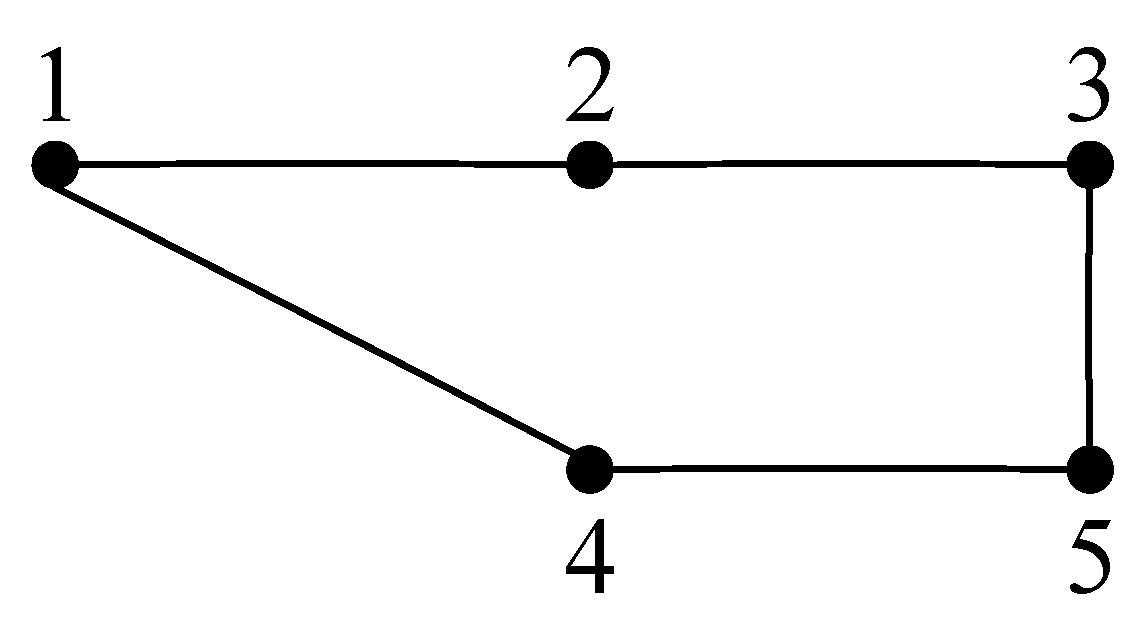
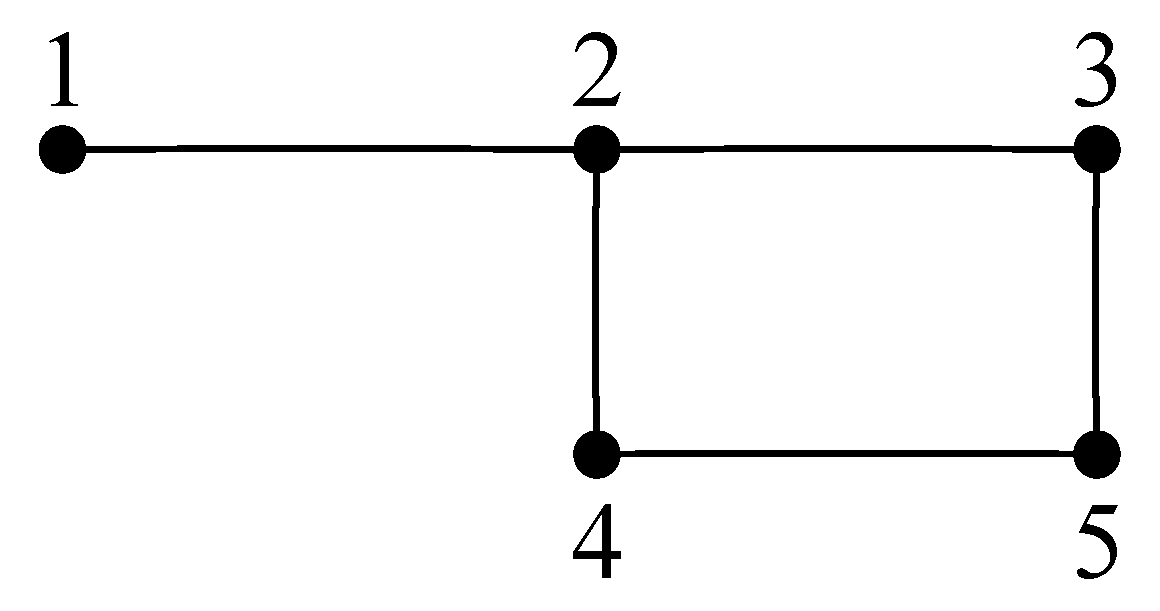
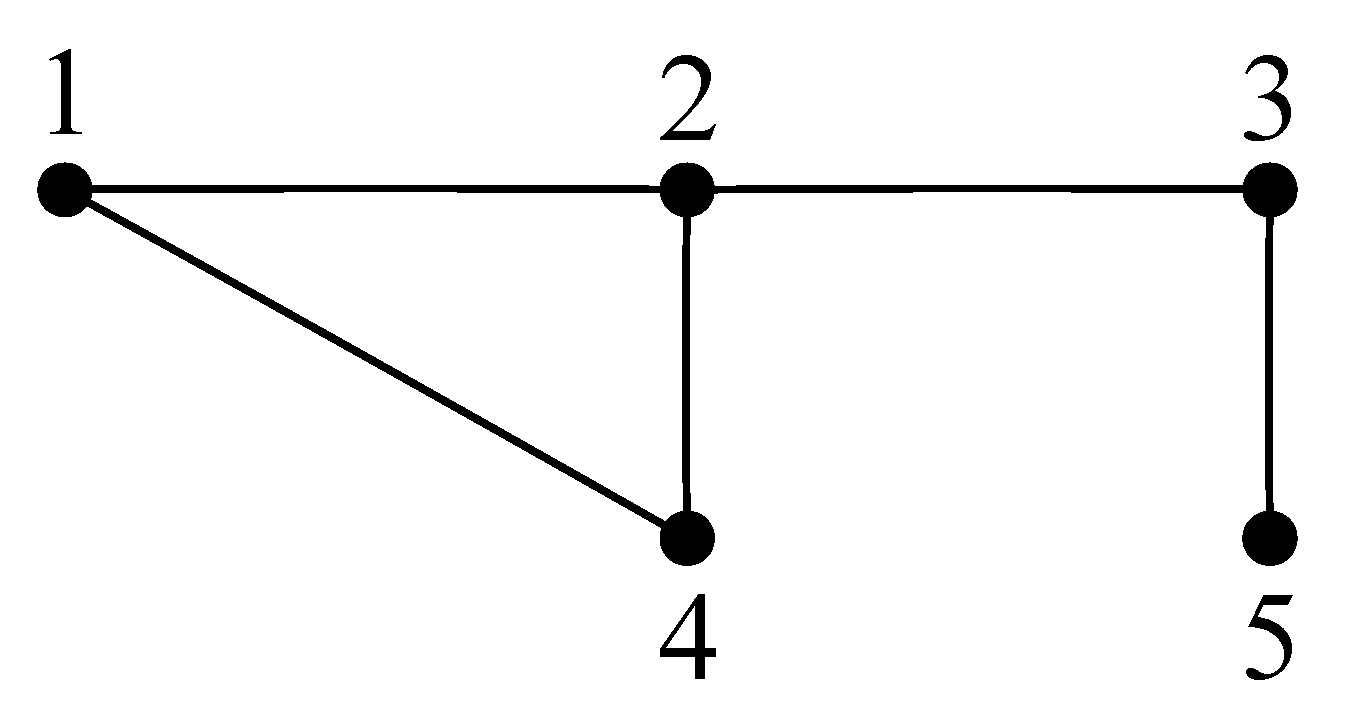

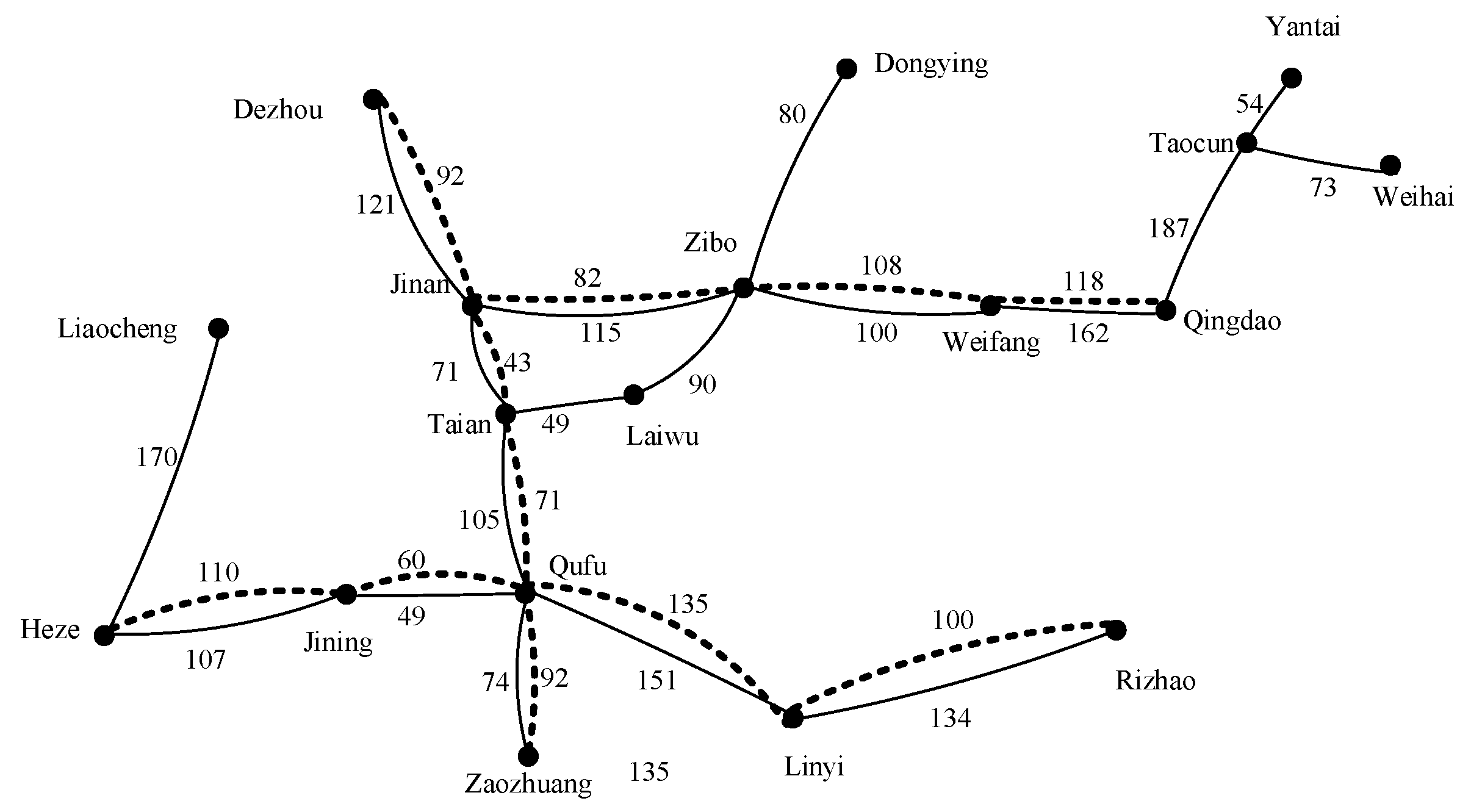
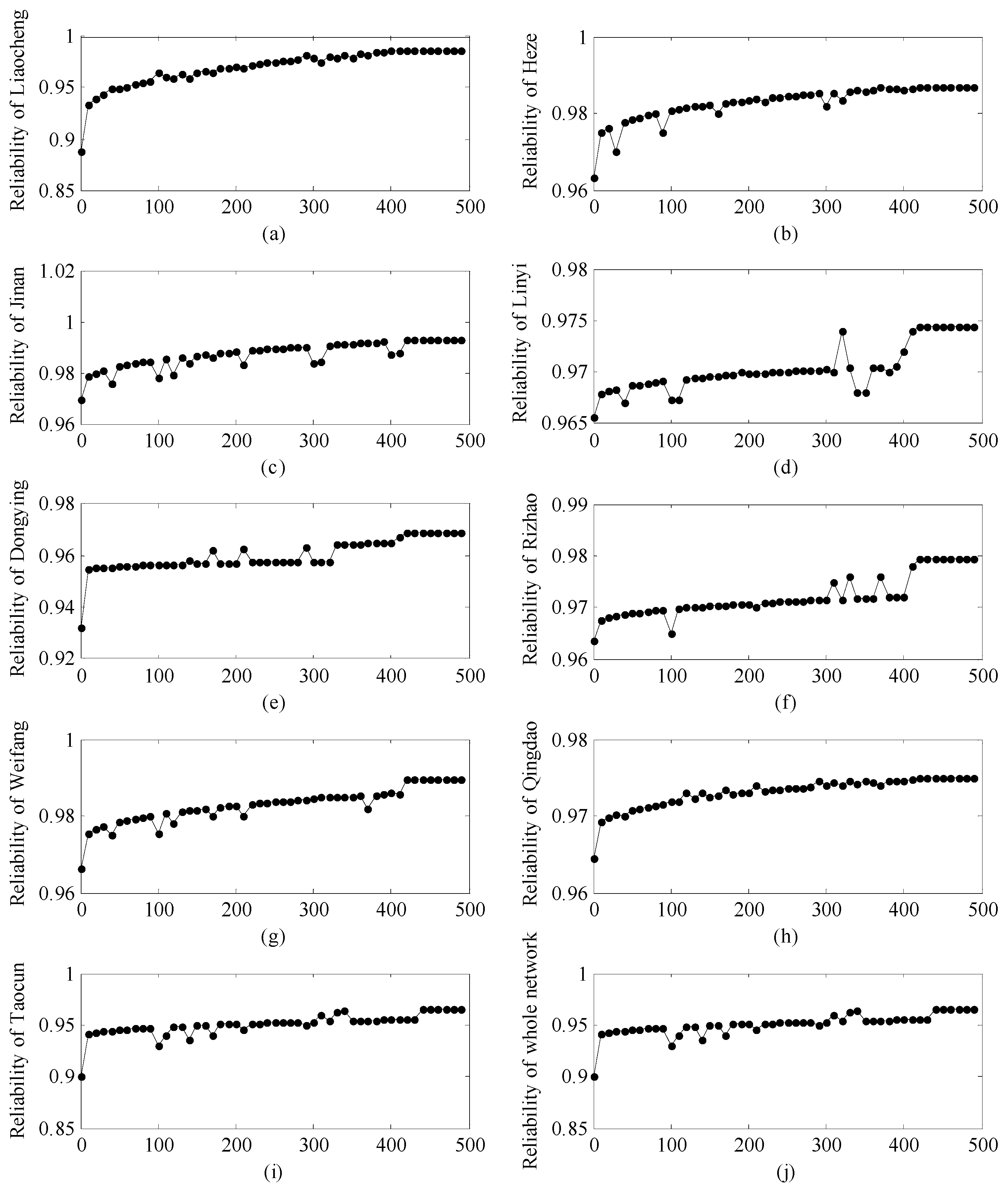
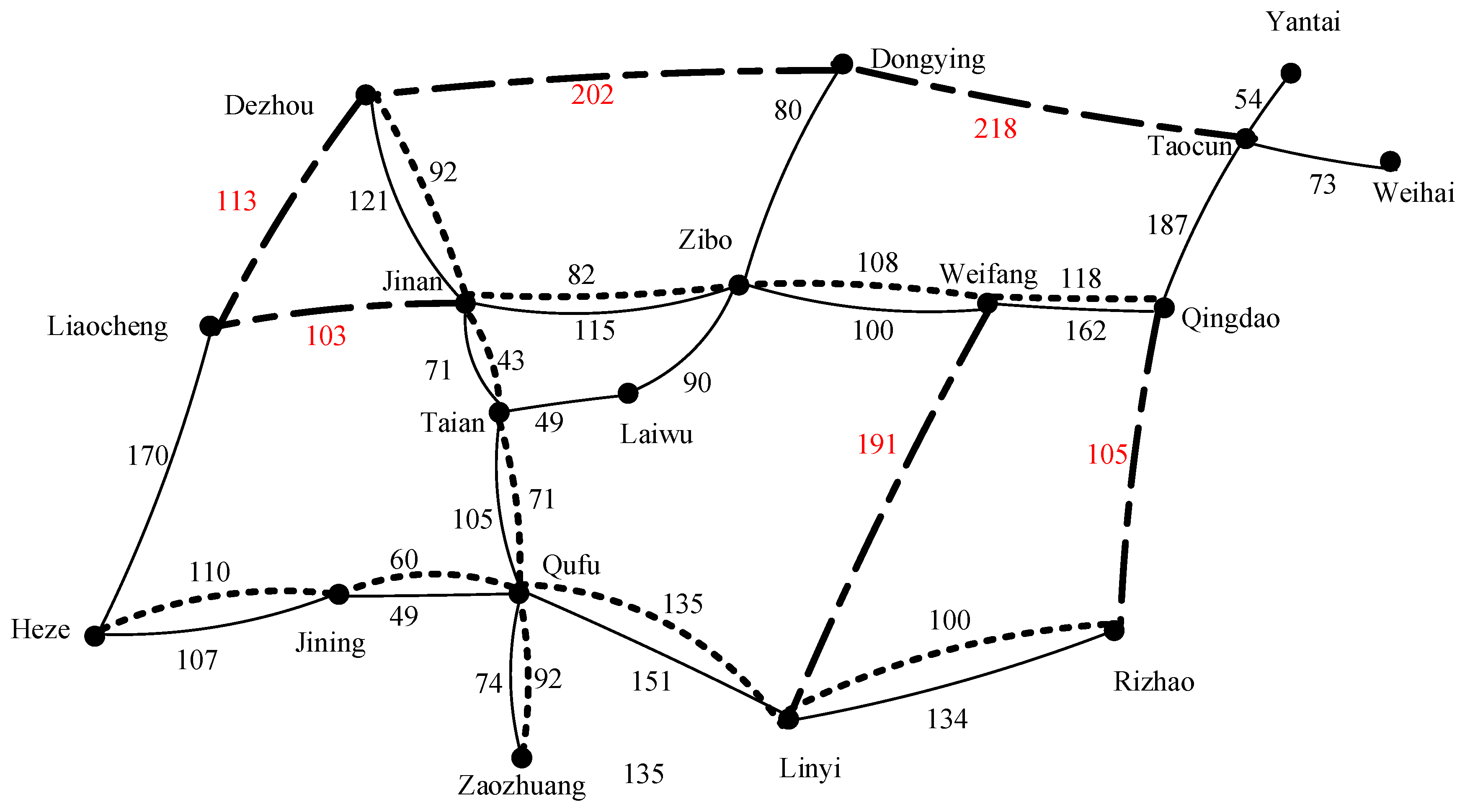
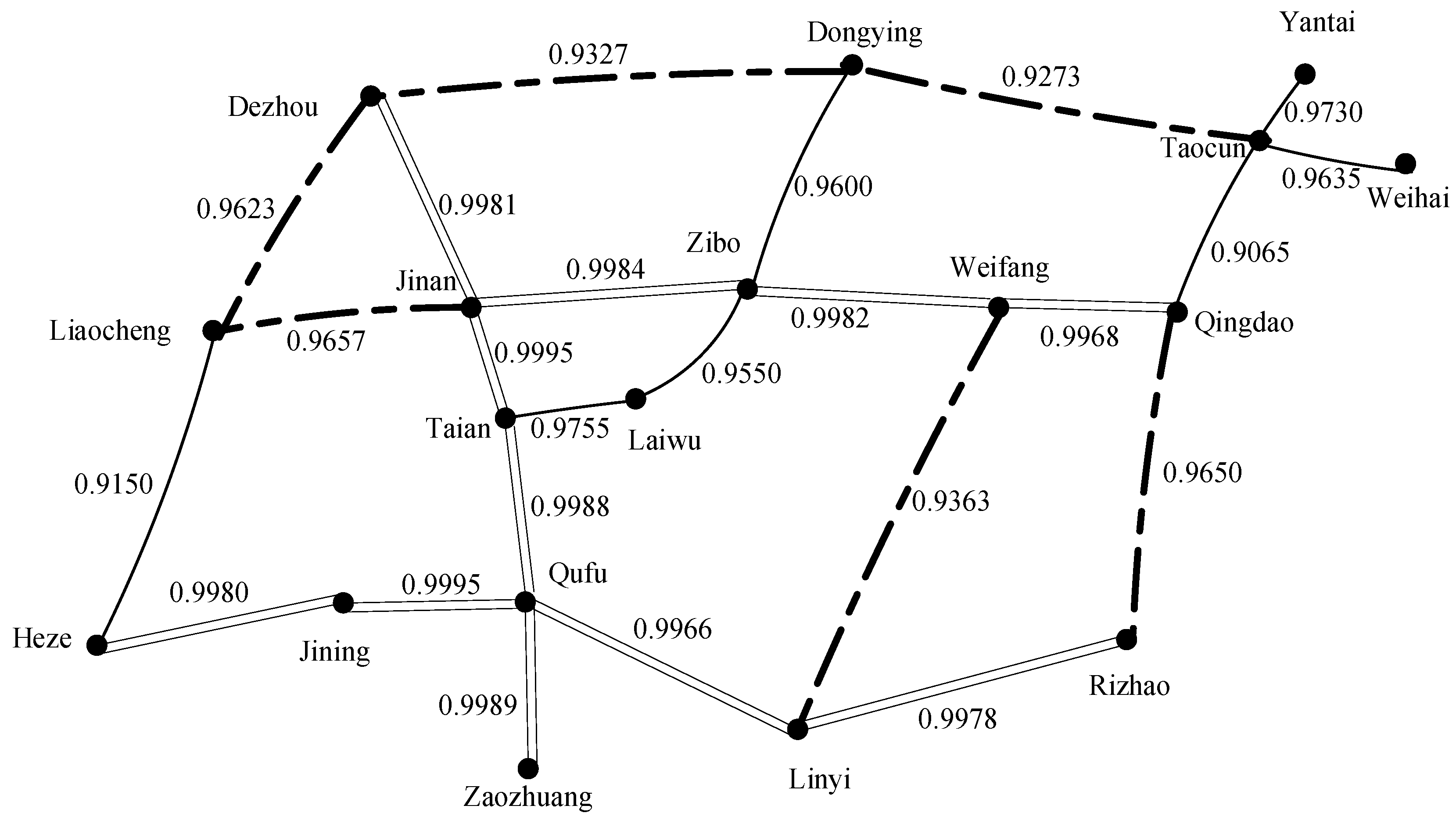
| Plan 1 | 1 | 2 | 3 | 4 | 5 |
|---|---|---|---|---|---|
| 1 | - | 0.88192 | 0.82432 | 0.88192 | 0.82432 |
| 2 | - | 0.88192 | 0.82432 | 0.82432 | |
| 3 | - | 0.82432 | 0.88192 | ||
| 4 | - | 0.88192 | |||
| 5 | - |
| Plan 2 | 1 | 2 | 3 | 4 | 5 |
|---|---|---|---|---|---|
| 1 | - | 0.8 | 0.72192 | 0.72192 | 0.8704 |
| 2 | - | 0.9024 | 0.9024 | 0.8704 | |
| 3 | - | 0.8704 | 0.9024 | ||
| 4 | - | 0.9024 | |||
| 5 | - |
| Plan 3 | 1 | 2 | 3 | 4 | 5 |
|---|---|---|---|---|---|
| 1 | - | 0.928 | 0.7424 | 0.928 | 0.59392 |
| 2 | - | 0.8 | 0.928 | 0.64 | |
| 3 | - | 0.7424 | 0.8 | ||
| 4 | - | 0.59392 | |||
| 5 | - |
| City | Abbreviation |
|---|---|
| Liaocheng | LC |
| Heze | HZ |
| Jining | JNI |
| Dezhou | DZ |
| Jinan | JNA |
| Taian | TA |
| Qufu | QF |
| Zaozhuang | ZZ |
| Laiwu | LW |
| Linyi | LY |
| Dongying | DY |
| Zibo | ZB |
| Rizhao | RZ |
| Weifang | WF |
| Qingdao | QD |
| Taocun | TC |
| Yantai | YT |
| Weihai | WH |
| LC | HZ | JNI | DZ | JNA | TA | QF | ZZ | LW | LY | DY | ZB | RZ | WF | QD | TC | YT | WH | |
|---|---|---|---|---|---|---|---|---|---|---|---|---|---|---|---|---|---|---|
| LC | 145 | 128 | 113 | 103 | 103 | 133 | 219 | 153 | 260 | 261 | 189 | 335 | 284 | 393 | 464 | 490 | 557 | |
| HZ | - | 255 | 215 | 178 | 141 | 172 | 226 | 259 | 375 | 287 | 364 | 366 | 450 | 553 | 588 | 644 | ||
| JNI | 227 | 146 | 98 | - | 92 | 132 | 162 | 292 | 203 | 264 | 272 | 348 | 454 | 490 | 545 | |||
| DZ | - | - | - | - | 179 | 313 | 202 | 165 | 361 | 259 | 389 | 422 | 447 | 507 | ||||
| JNA | - | - | - | 67 | 203 | 161 | 83 | 255 | 180 | 298 | 361 | 392 | 452 | |||||
| TA | - | - | 57 | 166 | 196 | 108 | 235 | 192 | 296 | 376 | 412 | 469 | ||||||
| QF | - | 94 | - | 252 | 164 | 227 | 227 | 308 | 413 | 446 | 501 | |||||||
| ZZ | 160 | 100 | 315 | 232 | 211 | 267 | 310 | 433 | 473 | 524 | ||||||||
| LW | 135 | 160 | 72 | 186 | 139 | 239 | 323 | 360 | 417 | |||||||||
| LY | 260 | 191 | - | 191 | 211 | 339 | 380 | 430 | ||||||||||
| DY | 88 | 236 | 91 | 214 | 218 | 243 | 302 | |||||||||||
| ZB | 203 | 99 | 224 | 275 | 308 | 367 | ||||||||||||
| RZ | 147 | 105 | 244 | 285 | 328 | |||||||||||||
| WF | 130 | 183 | 218 | 276 | ||||||||||||||
| QD | 142 | 181 | 221 | |||||||||||||||
| TC | 39 | 94 | ||||||||||||||||
| YT | 57 | |||||||||||||||||
| WH |
| LC | HZ | JNI | DZ | JNA | TA | QF | ZZ | LW | LY | DY | ZB | RZ | WF | QD | TC | YT | WH | |
|---|---|---|---|---|---|---|---|---|---|---|---|---|---|---|---|---|---|---|
| LC | 0.9150 | 0.9132 | 0.9089 | 0.9111 | 0.9116 | 0.9127 | 0.9117 | 0.8893 | 0.9096 | 0.8746 | 0.9110 | 0.9076 | 0.9094 | 0.9064 | 0.8217 | 0.7995 | 0.7917 | |
| HZ | 0.9980 | 0.9173 | 0.9958 | 0.9963 | 0.9975 | 0.9964 | 0.9719 | 0.9941 | 0.9738 | 0.9957 | 0.9919 | 0.9939 | 0.9907 | 0.8981 | 0.8738 | 0.8654 | ||
| JNI | 0.9954 | 0.9978 | 0.9983 | 0.9995 | 0.9984 | 0.9738 | 0.9961 | 0.9578 | 0.9977 | 0.9939 | 0.9959 | 0.9927 | 0.8999 | 0.8756 | 0.8671 | |||
| DZ | 0.9981 | 0.9976 | 0.9959 | 0.9948 | 0.9969 | 0.993 | 0.9581 | 0.9980 | 0.9903 | 0.9947 | 0.9930 | 0.9002 | 0.8759 | 0.8673 | ||||
| JNA | 0.9995 | 0.9983 | 0.9972 | 0.9988 | 0.9949 | 0.9599 | 0.9999 | 0.9927 | 0.9981 | 0.9949 | 0.9019 | 0.8775 | 0.8690 | |||||
| TA | 0.9988 | 0.9977 | 0.9755 | 0.9954 | 0.9599 | 0.9999 | 0.9932 | 0.9981 | 0.9949 | 0.9019 | 0.8775 | 0.8690 | ||||||
| QF | 0.9989 | 0.9743 | 0.9966 | 0.9589 | 0.9987 | 0.9944 | 0.9969 | 0.9937 | 0.9008 | 0.8765 | 0.8679 | |||||||
| ZZ | 0.9732 | 0.9955 | 0.9578 | 0.9976 | 0.9933 | 0.9958 | 0.9926 | 0.8998 | 0.8755 | 0.8669 | ||||||||
| LW | 0.9710 | 0.9168 | 0.9550 | 0.9689 | 0.9532 | 0.9502 | 0.8614 | 0.8381 | 0.8299 | |||||||||
| LY | 0.9556 | 0.9953 | 0.9987 | 0.9935 | 0.9903 | 0.8977 | 0.8735 | 0.8650 | ||||||||||
| DY | 0.9600 | 0.9534 | 0.9583 | 0.9552 | 0.8659 | 0.8425 | 0.8343 | |||||||||||
| ZB | 0.9931 | 0.9982 | 0.9950 | 0.9020 | 0.8776 | 0.8691 | ||||||||||||
| RZ | 0.9913 | 0.9881 | 0.8957 | 0.8716 | 0.8631 | |||||||||||||
| WF | 0.9968 | 0.9036 | 0.8792 | 0.8706 | ||||||||||||||
| QD | 0.9065 | 0.8820 | 0.8734 | |||||||||||||||
| TC | 0.9730 | 0.9635 | ||||||||||||||||
| YT | 0.9375 | |||||||||||||||||
| WH |
| Connection Reliability before Optimization | Connection Reliability after Optimization | Difference | |
|---|---|---|---|
| LC | 0.8885 | 0.9870 | 0.0985 |
| HZ | 0.9627 | 0.9803 | 0.0176 |
| JNI | 0.9677 | 0.9911 | 0.0234 |
| DZ | 0.9633 | 0.9867 | 0.0234 |
| JNA | 0.9697 | 0.9927 | 0.0230 |
| TA | 0.9685 | 0.9914 | 0.0229 |
| QF | 0.9683 | 0.9911 | 0.0228 |
| ZZ | 0.9672 | 0.9902 | 0.0230 |
| LW | 0.9411 | 0.9651 | 0.0240 |
| LY | 0.9656 | 0.9745 | 0.0089 |
| DY | 0.9319 | 0.9690 | 0.0371 |
| ZB | 0.9673 | 0.9886 | 0.0213 |
| RZ | 0.9636 | 0.9794 | 0.0158 |
| WF | 0.9663 | 0.9894 | 0.0231 |
| QD | 0.9645 | 0.9750 | 0.0105 |
| TC | 0.8996 | 0.9653 | 0.0657 |
| YT | 0.8769 | 0.9408 | 0.0639 |
| WH | 0.8689 | 0.9380 | 0.0691 |
| LC | HZ | JNI | DZ | JNA | TA | QF | ZZ | LW | LY | DY | ZB | RZ | WF | QD | TC | YT | WH | |
|---|---|---|---|---|---|---|---|---|---|---|---|---|---|---|---|---|---|---|
| LC | 0.9150 | 0.9997 | 0.9986 | 0.9986 | 0.9998 | 0.9997 | 0.9986 | 0.9974 | 0.9963 | 0.9957 | 0.9985 | 0.9941 | 0.994 | 0.9963 | 0.9865 | 0.9599 | 0.9506 | |
| HZ | 0.9980 | 0.9137 | 0.9995 | 0.9996 | 0.9975 | 0.9964 | 0.9751 | 0.9941 | 0.9966 | 0.9994 | 0.9919 | 0.9963 | 0.9941 | 0.9866 | 0.9600 | 0.9506 | ||
| JNI | 0.9978 | 0.9997 | 0.9983 | 0.9995 | 0.9984 | 0.9738 | 0.9961 | 0.9968 | 0.9982 | 0.9939 | 0.9963 | 0.9986 | 0.9888 | 0.9621 | 0.9527 | |||
| DZ | 0.9981 | 0.9976 | 0.9964 | 0.9953 | 0.9969 | 0.9930 | 0.9971 | 0.9996 | 0.9908 | 0.9962 | 0.9986 | 0.9888 | 0.9621 | 0.9527 | ||||
| JNA | 0.9995 | 0.9983 | 0.9972 | 0.9988 | 0.9949 | 0.9971 | 0.9999 | 0.9927 | 0.9981 | 0.9989 | 0.9891 | 0.9624 | 0.9530 | |||||
| TA | 0.9988 | 0.9977 | 0.9755 | 0.9954 | 0.9966 | 0.9999 | 0.9932 | 0.9981 | 0.9989 | 0.9891 | 0.9624 | 0.9530 | ||||||
| QF | 0.9989 | 0.9743 | 0.9966 | 0.9954 | 0.9987 | 0.9944 | 0.9998 | 0.9966 | 0.9891 | 0.9624 | 0.9530 | |||||||
| ZZ | 0.9732 | 0.9955 | 0.9943 | 0.9988 | 0.9933 | 0.9987 | 0.9955 | 0.988 | 0.9613 | 0.9520 | ||||||||
| LW | 0.9969 | 0.9168 | 0.9550 | 0.9947 | 0.9533 | 0.9502 | 0.9447 | 0.9192 | 0.9102 | |||||||||
| LY | 0.9597 | 0.9997 | 0.9987 | 0.9974 | 0.9975 | 0.9042 | 0.8798 | 0.8712 | ||||||||||
| DY | 0.9600 | 0.9581 | 0.9932 | 0.9929 | 0.9273 | 0.9023 | 0.8935 | |||||||||||
| ZB | 0.9957 | 0.9982 | 0.999 | 0.9892 | 0.9625 | 0.9531 | ||||||||||||
| RZ | 0.9975 | 0.9999 | 0.9064 | 0.8819 | 0.9733 | |||||||||||||
| WF | 0.9968 | 0.9893 | 0.9626 | 0.9532 | ||||||||||||||
| QD | 0.9065 | 0.8820 | 0.8734 | |||||||||||||||
| TC | 0.9730 | 0.9635 | ||||||||||||||||
| YT | 0.9375 | |||||||||||||||||
| WH |
Publisher’s Note: MDPI stays neutral with regard to jurisdictional claims in published maps and institutional affiliations. |
© 2020 by the authors. Licensee MDPI, Basel, Switzerland. This article is an open access article distributed under the terms and conditions of the Creative Commons Attribution (CC BY) license (http://creativecommons.org/licenses/by/4.0/).
Share and Cite
Meng, X.; Wang, Y.; Jia, L.; Li, L. Reliability Optimization of a Railway Network. Sustainability 2020, 12, 9805. https://doi.org/10.3390/su12239805
Meng X, Wang Y, Jia L, Li L. Reliability Optimization of a Railway Network. Sustainability. 2020; 12(23):9805. https://doi.org/10.3390/su12239805
Chicago/Turabian StyleMeng, Xuelei, Yahui Wang, Limin Jia, and Lei Li. 2020. "Reliability Optimization of a Railway Network" Sustainability 12, no. 23: 9805. https://doi.org/10.3390/su12239805
APA StyleMeng, X., Wang, Y., Jia, L., & Li, L. (2020). Reliability Optimization of a Railway Network. Sustainability, 12(23), 9805. https://doi.org/10.3390/su12239805




